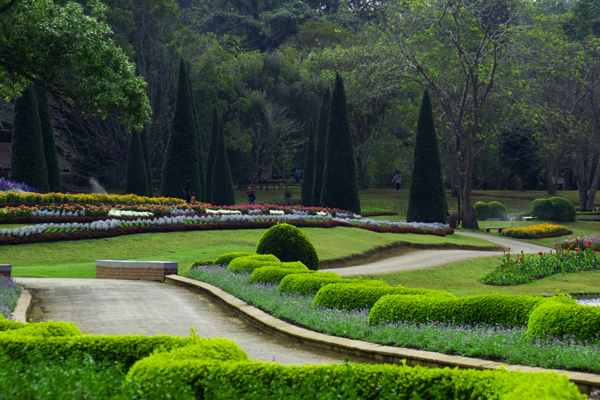Pyin Oo Lwin
Pyin Oo Lwin formerly known as Maymyo, is a highland town in Mandalay Division. In 1896, British military established the city and named Maymyo.( May’s town) . It became the summer capital of British Burma to escape the heat of Yangon. Later, the military government of Burma renamed Pyin Oo Lwin. Sweater Knitting, flower and vegetable gardens, strawberry and pineapple orchards, coffee plantations and cow rearing are the main local business of the town.
Pyin Oo Lwin’s Attractions
- Colonial Houses
- Chan Tak Buddhist Temple
- Pyin Oo Lwin Market
- Pucell Tower
- Mahar Ant Htoo Kan Thar Pagoda
- Dattawgyaik Waterfall
- Peik Chin Myaung Cave or Maha Nandamu Pagoda
- Pwe Kout Waterfall
- National Landmark Garden Pyin Oo Lwin
- National Kandawgyi Garden
Maha Anthtookanthar Paya
There were no plans to build a pagoda where the Maha Anthtookanthar Paya is located. Fate seems to have played a big part in bringing it here. It is said that three Buddha statues made in Mandalay were being transported to their destination in China. During the long journey, one of the Buddha figures fell out from the lorry that was transporting them. Try as they might, the heavy statue could not be lifted off the ground to load back onto the truck. After several futile attempts, it was left behind while the other two continued their journey to China. The Buddha image that was left behind had to be moved from the road, but no one had a clue how to go about this difficult task. Finally, a local Buddhist monk took upon himself to use his faith to find a solution. He sat next to this figure for seven days all the while preaching to the locals and reciting teachings of the Buddha. After seven days, they had no difficulty in lifting and moving it to a new location. And that’s where it remains to this day, where the local people built a pagoda to house it as an offering to the Buddha.
.

Peik Chin Myaung Maha Nandamu Cave
The Maha Nandamu Cave is 12 miles east of the town and lies 3 miles south of Wetwun village. Easily accessible by car, the cave is at the entrance to the Peik Chin Myaung ravine with many beautiful springs. During the time when the rocks in the cave were gradually forming, the place lay under seawater. It was the lime that slowly piled up over the years that formed the hillock. Geologists estimate that it could be between 230 million and 310 million years old. The cave Peik Chin Myaung (Peik Chin Plants Ravine) gets its name from the Peik Chin plants that used to grow there in abundance preventing natural light from entering inside. This Great Cave of rock was born out of a fault. As water seeped in and dripped from the rocks and limestone, stalactites began to form taking the shape of chandeliers. Standing at the entrance to the cave, one can observe natural springs flowing down from various directions. The water accumulated at some places is as deep as five feet. The water is cool and crystal clear as it seeps from the walls of the rock. It is commonly believed that this water can cure eye ailments and itching. Hence, most pilgrims collect this spring water to take home in bottles.
The Great cave spreads over an area of about 48 acres and the interior is cold and damp because of the springs and small waterfalls everywhere. The life story of the Buddha leading up to His Enlightenment is depicted at appropriate places around the cave, and in corners and niches, one finds Buddha images and pagodas.
Pwe Kauk Fall
Pwe Kauk Fall is about 8 km from Pyin Oo Lwin. It was called Hampshire Falls during British rule and is a popular picnic spot. The spot has beautiful scenery with enchanting wild flowers. Pwe Kauk Fall attracts both locals as well as tourists.
Kandawgyi Botanical Garden
One of the historical places is the Kandawgyi Botanical Garden which was founded in 1915-16 by Mr. Roger, a British botanist who began collecting local plants and trees which he cultivated on 30 acres of land at the present site. It was officially sanctioned by the government in 1919. Spread over 240 acres, the original botanical garden consisted of 170 acres of land and 70 acres of water and was supplied by a constant flow of spring water from the lake nearby. The layout of the garden was based on the design of the Kew Gardens in England. In 1920, the Forest Department declared the Botanical Garden a forest reserve and brought it under the jurisdiction of the Department. 4,840 trees, mostly pine varieties, 575 different floral species and many exotic fruit trees were planted here. Vast meadows and several seasonal flower beds were arranged and hundreds of wild orchids from different parts of the country were collected and displayed in the Orchid Green House within the garden. With its vast collection of exotic flora, the garden earned fame as a world class botanical garden.
How to get to Pyin Oo Lwin
By Train
The train station is north of the city and there are services to and from Mandalay, Hsipaw and Lashio. Trains from Mandalay leave at 04:00 arriving at 07:52 (but delays are common).
Getting Around in Pyin Oo Lwin
It is easy to get around in Pyin Oo Lwin on foot or on bicycle. Or hire a gharry, old garishly painted horse-drawn Victorian carriages that live on in Pyin U Lwin. For far-flung places, you can get a motorcycle taxi near the market or there are also motocycle renting.
